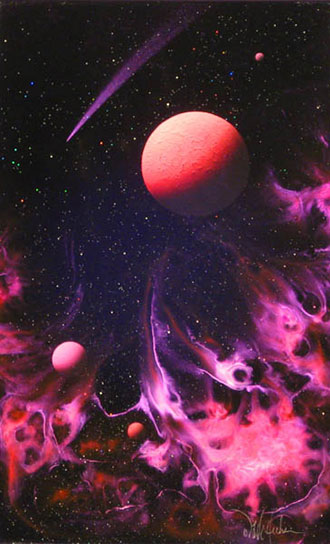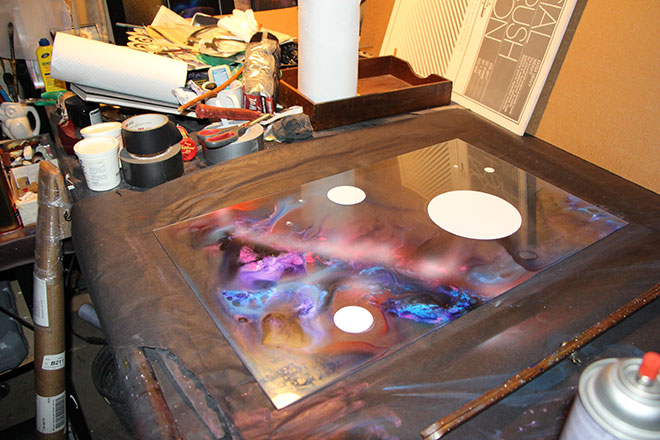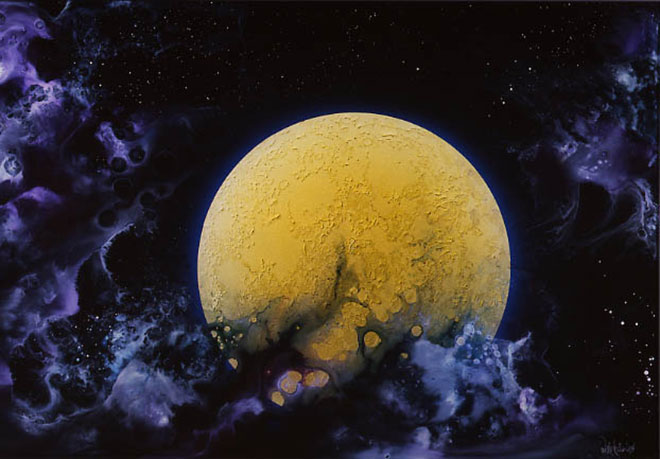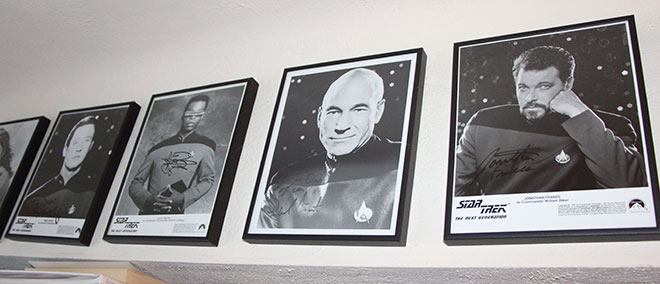Heavenly images:
Local artist Dave Archer reaches for the stars

Standing beside a 4-foot metallic orb with a mysterious looking wand in his hand, local artist Dave Archer reminisces about his life in the art world and San Francisco beat culture as he prepares to transfer 1 million volts of electricity onto paint applied to a pane of glass.
Archer, a local artist who lives in Roseburg, pioneered the process known as reverse glass painting which employs the use of a Tesla Coil to shock paint onto a sheet of glass. The results produce heavenly looking objects similar to those seen in space captured by the Hubble Telescope. Archer’s work has brought him worldwide fame, fortune and friendships with some of the most iconic figures of the last fifty years.

Originally from San Luis Obispo, California, Archer was influenced by the work of Pablo Picasso and other Cubists who were instrumental in painting, sculpting, and print techniques known as the plastic arts. An instructor also created a watershed moment for him. “One of my early art teachers told all the other students to listen to me because I was an artist” Archer said. Archer described this as a “seminal moment” that gave him the confidence to become a painter.
Archer’s interest in the glass medium may also go back to his early education. “We had a sixty foot plate glass window at school that students competed for the right to decorate for Christmas; the first year I won the center space, and the next year I became the first student to paint the entire thing,” Archer said.
His art caught the attention of Phil Paradise, a popular artist in the 1950’s, and Archer was given a scholarship to apprentice at Paradise’s studio. Archer credits Paradise’s mentorship as a driving factor in his sustained success “Phil taught me how to be a professional - things like how to price your work, meet deadlines and how to network.”
In the early 1960s, Archer was drawn to the North Beach area of San Francisco by the writings of Jack Kerouac, Allen Ginsberg and others in the emerging Beat Generation movement. “I became friends with Janis Joplin, Hoyt Axton and Steve Martin,” Archer says.
For the next ten years, Archer traveled the country and across Mexico using North Beach as his home base explaining that “Kerouac’s book ‘On the Road’ served as a guide for all of us to go out and live, see and experience the world while we were young and full of energy.” Throughout the 60s Archer worked in a variety of different jobs while continuing to work on his art, including a stint as a PR agent for a Bay Area publisher. This experience would prove to be instrumental later in his career.

In the early 1970s, Archer married, started a family and prepared to end his quest to become a professional artist. A friend and fellow painter, Ron Russell, however, suggested that the two begin painting on glass as a way to distinguish their work. Unconvinced of its viability but encouraged by another friend, Archer and Russell began to experiment with electricity.
“It’s alive!” is how Archer describes is first reaction to the medium. Even early in the experiments, Archer was excited “I knew from my experience as both a PR agent and a painter that we were on to something; the images came out very vivid and spacey - keep in mind this was decades before the Hubble telescope images but that’s a good comparison.”
Archer found success almost immediately “I hit the art show circuit for about 10 years, and with a combination of PR skills and my product I was able to make a 6-figure income.” His networking skills also helped him to get the attention of Mark Hamill who played Luke Skywalker in the Star Wars saga. “Mark attached his name to my work and allowed me to use autographed photos of him to help me market it,” says Archer.
By the end of the 70’s, Archer had become tired of the art show scene, his partner Russell had moved on a few years earlier. He decided to make a change, “I contracted with a gallery in San Francisco, and it coincided with huge spike in the price of art.” He described the 1980’s as a period of time where art was being purchased at record prices because of perceived investment values. It all came to crash though when one of Van Gogh’s paintings went for around $80 million, but I began to make a $1 million annually before it happened.”

In the 1990s Archer hired a publicist who began to further market his work to press outlets and movie studios. “My publicist walked onto the Star Trek set and showed them a couple pieces of my work, and they bought it on the spot,” Archer says. Indeed, he became one of only three people with the privilege of decorating the iconic Enterprise spaceship. His work can be seen in Star Trek The Next Generation, VI and the Generations television and film series.
Archer has been featured in programs such as Ripley’s Believe It or Not and has been interviewed by national and worldwide media outlets on hundreds of occasions. He relocated to Roseburg around 15 years ago to help care for his mother and to begin a life of semi retirement. But that doesn’t mean he is slowing down. “I have one student that I work with everyday, and I still sell quite a bit of my work,” Archer says. Archer also hopes to release a book by the end of the year titled “Survival Art: Painting and Sculpting for Food, Clothing and Shelter” which will impart the wisdom of a life in art to those who strive to make it in the profession.
Across the walls of his home hang pictures of Archer and many of the famous people that he worked with over the years. His talent has given him a rewarding and unique life full of perspective; when asked for any advice he would give to anyone considering a career in the arts Archer says “There has never been a better time to become an artist; new technologies like 3D printers are making the impossible possible for painters and sculptors alike.” If you would like to learn more about Dave Archer visit his website at www.DaveArcher.com.

